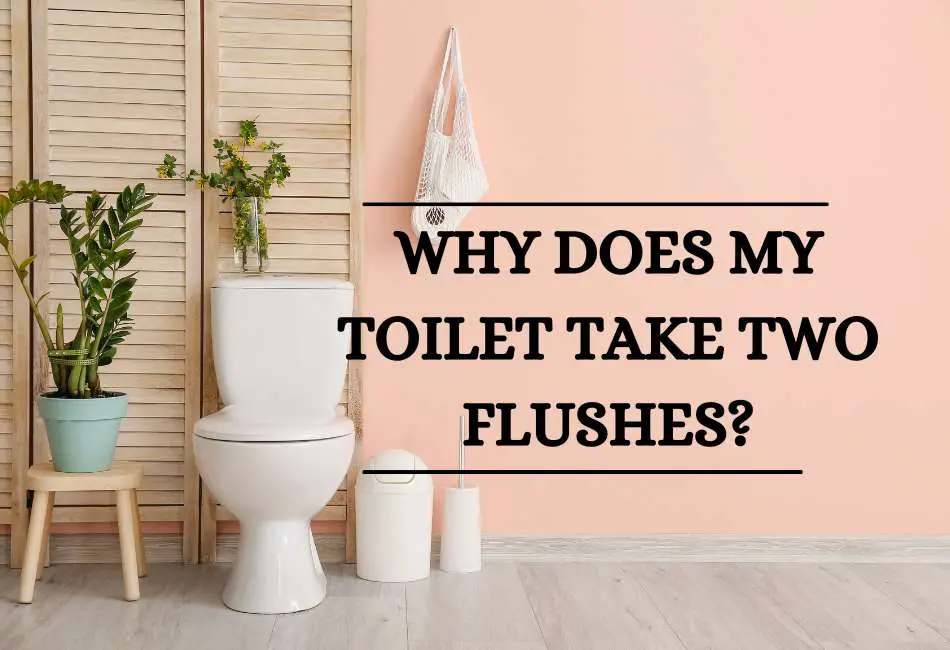Nothing puts a damper on your day like the annoyance of having to flush your toilet twice. It’s a common frustration many share, shifting from a minor inconvenience to a pesky routine.
However, understanding the reasons behind this seemingly trivial issue can be a game-changer in managing your home’s plumbing system.
In this guide, we will explore six key factors that could be causing your toilet to require an encore performance.
We’ve got you covered, from simple issues you can fix in a jiffy to more complex problems that might need a professional’s help!
1. Inadequate Water Level
Now, I’m sure we’ve all had those moments where we’ve stared in confusion at our toilet, wondering why it just won’t flush properly on Earth.
Allow me to introduce you to a common culprit – the water level in your toilet tank. Believe it or not, the water level is pivotal in flushing.
How to Check and Adjust the Water Level in the Toilet Tank
So, how do you check the water level in your toilet tank? It’s simpler than you might think. Just lift the lid off your toilet tank (don’t worry, it’s not as gross as it sounds), and you’ll see a marked line inside the tank.
That line is your desired water level. If the water is significantly below that line after a flush, you’ve probably found your problem.
Adjusting the water level is also a breeze. Turn the adjustment screw on the fill valve (the tall thing with the float) to raise or lower the water level.
The Connection Between Low Water Levels and Insufficient Flush Power
If your tank’s water level is too low, it won’t have enough ‘oomph’ to clear your toilet bowl in one fell swoop. It’s like trying to wash your car with a water gun. It’ll get wet, but you’ll be there all day.
2. Faulty Flapper Valve
Ah, the flapper valve – the unsung hero of the toilet world. This little rubber piece controls the amount of water that enters your toilet bowl from the tank when you flush.
Signs of a Malfunctioning Flapper Valve
A faulty flapper valve can be the sneakiest thief, stealing the power from your flush without realizing it.
If your toilet seems to be constantly running, or it takes an age to fill up post-flush, you might be dealing with a defective flapper valve. It can also cause leakage, leading to water wastage.
Importance of Replacing a Faulty Flapper Valve for Efficient Flushing
All it takes is one faulty flapper valve to ruin your toilet’s flushing capability. Replacing it ensures your toilet has enough water for a complete, powerful flush every time.
When I replaced the flapper valve in my upstairs bathroom, it was like my toilet had suddenly been reborn. Trust me, it’s worth the effort.
3. Mineral Buildup in the Flush Holes
Ah, mineral buildup – the silent strangler of flush efficiency. It’s a common problem, especially in areas with hard water.
Over time, mineral deposits from the water can accumulate in the flush holes, slowly reducing the amount of water that can pass through.
Effects of Mineral Buildup on Flush Efficiency
My Aunt Mabel’s toilet was a classic example. The flush was more of a whimper than a roar, and it was all down to pesky mineral deposits.
They had effectively choked her toilet’s flush holes, diminishing its power significantly. It’s a sneaky process that creeps up on you, much like Aunt Mabel at family reunions.
Solutions for Cleaning and Preventing Mineral Deposits
To tackle this, I used a coat hanger to scrape away the deposits, followed by a gentle scrub with a toothbrush – not my own, I hasten to add.
A white vinegar soak overnight can work wonders too. As for prevention, a toilet-cleaning tablet designed to combat hard water can keep those minerals at bay.
4. Clogged Trapway
Let’s chat about the trapway. The curved pipe in your toilet carries waste from the bowl to the sewer line. Imagine it as a highway for… well, you get the idea.
Causes of Trapway Blockage
I once had a friend who called me in a panic, her toddler having decided that his toy dinosaur needed a swim in the toilet’s “pool.”
This resulted in a clogged trapway that only a plunger and serious elbow grease could fix.
Excessive toilet paper use, hygiene products, and even those “flushable” wipes can lead to blockages.
DIY Methods and Professional Solutions for Clearing a Clogged Trapway
I managed to free the dinosaur with a good, old-fashioned plunger. But sometimes, a plunger alone won’t cut it.
The next step up is a toilet auger, designed to reach further into the trapway and break up stubborn clogs. If all else fails, though, don’t despair.
A professional plumber has more specialized tools and the know-how to handle even the most stubborn of toilet blockages. Trust me, they’ve seen it all.
6. Inefficient Flushing Mechanism
Here we are, the granddaddy of all causes: the big, bad, flushing mechanism. It’s the beating heart of your toilet, the star of the show. Our flushing heroes are composed of several components including the flush valve and the flapper. You’ve got the trip lever, that’s the shiny handle you jiggle when things go awry.
Common Issues with Flushing Mechanisms
But like any star, it can be a diva. Common issues could range from a flapper not sealing properly to a low water level in the tank. I remember a time when my flapper was acting more like a flopper. Not a pretty sight and definitely not efficient.
Importance of Regular Maintenance for Optimal Flushing Performance
Regular maintenance is like the VIP pass to stellar performance. A well-oiled machine is a happy machine. I’ve found that a little TLC goes a long way in preventing embarrassing encounters with the double-flush dilemma.
7. Low-Flow Toilet Design
Moving on to the unsung heroes of water conservation – low-flow toilets. Compared to older models, these champs use 1.28 gallons per flush, which gulps 3.5 to 7 gallons per flush.
I installed one last year, and let me tell you, the water bill dropped faster than a hot potato.
Challenges Associated with Low-Flow Toilets
But they are not without their issues. Due to their water-saving design, low-flow toilets may require double flushes or frequent plunger interventions. It’s like trading one problem for another. Quite the quandary!
Tips for Maximizing the Efficiency of Low-Flow Toilets
Don’t fret, though. I’ve found that a little know-how can keep these challenges at bay. Regular maintenance and wise usage (read: not using it as a trash can) can maximize the efficiency of your low-flow toilet.
Conclusion
So, we’ve traversed the labyrinth of double-flushing dilemmas and come out the other side. Let’s take a moment to recollect the six evil villains behind these flushing woes.
- Blockages: Those sneaky little offenders clogging up your sewage line. Remember how my neighbor’s kid’s toys turned their toilet into a block party? Not a party anyone wants an invite to, right?
- Mineral Deposits: The silent stone-makers slowly build up and reduce the flushing efficiency. I learned this the hard way when my toilet became a geological hotspot.
- Broken Flapper: The rogue flapper that fails to create a proper seal, leading to a constant trickle of water. I lost hours of sleep to that ghostly sound until I pinpointed the culprit.
- Faulty Fill Valve: This trickster can overfill or underfill the tank, messing up your flush. My first DIY plumbing project was replacing one of these bad boys – quite an adventure!
- Incorrect Toilet Design: An ill-designed loo guzzles water. My old-school toilet was a prime example, using more water than a marathon runner!
- Misadjusted Float: The mischievous misaligned float messes with water levels. Fixing one was like solving a waterlogged Rubik’s cube!
But let’s not forget our unsung heroes: regular maintenance and the low-flow toilet. Armed with a plunger, a toilet snake, and some know-how, you can keep your loo running smoothly and efficiently. Remember, a well-cared-for toilet is your best defense against double-flushing dramas.
As we bid adieu, my parting words are this: let’s not let the double flush dilemma get the better of us.
Tackle these issues head-on, not just for a hassle-free bathroom experience but also for the planet.
Every drop of water saved is a step toward a more sustainable future. Remember my water bill plummeted when I switched to a low-flow toilet? You, too, can be a water-saving warrior.
So, here’s to single flushes, regular maintenance, and a future of seamless bathroom experiences. Until next time, happy flushing, folks!

